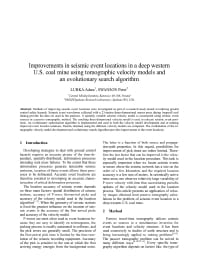Mining Publication: Improvements in Seismic Event Locations in a Deep Western U.S. Coal Mine Using Tomographic Velocity Models and an Evolutionary Search Algorithm
Original creation date: September 2009
Authors: A Lurka, PL Swanson
NIOSHTIC2 Number: 20036297
Min Sci Technol (China) 2009 Sep; 19(5):599-603
Methods of improving seismic event locations were investigated as part of a research study aimed at reducing ground control safety hazards. Seismic event waveforms collected with a 23-station three-dimensional sensor array during longwall coal mining provide the data set used in the analyses. A spatially variable seismic velocity model is constructed using seismic event sources in a passive tomographic method. The resulting three-dimensional velocity model is used to relocate seismic event positions. An evolutionary optimization algorithm is implemented and used in both the velocity model development and in seeking improved event location solutions. Results obtained using the different velocity models are compared. The combination of the tomographic velocity model development and evolutionary search algorithm provides improvement to the event locations.

NIOSHTIC2 Number: 20036297
Min Sci Technol (China) 2009 Sep; 19(5):599-603
- Analysis of Multiple Seam Stability
- Application of a Convolutional Neural Network for Seismic Phase Picking of Mining-induced Seismicity
- Determination of Sound Exposures (DOSES): Software Manual and Implementation Guide
- Investigation of a Rock-Burst Site, Sunshine Mine, Kellogg, Idaho
- Local Earthquake Tomography for Imaging Mining-Induced Changes Within the Overburden above a Longwall Mine
- ObsPlus: A Pandas-centric ObsPy Expansion Pack
- Rock Bursting and Seismicity During Ramp Development, Lucky Friday Mine, Mullan, Idaho
- Safer Mine Layouts for Underground Stone Mines Subjected to Excessive Levels of Horizontal Stress
- Task Analysis
- Technology News 536 - NIOSH Develops New Software to Analyze and Reduce Noise Exposure